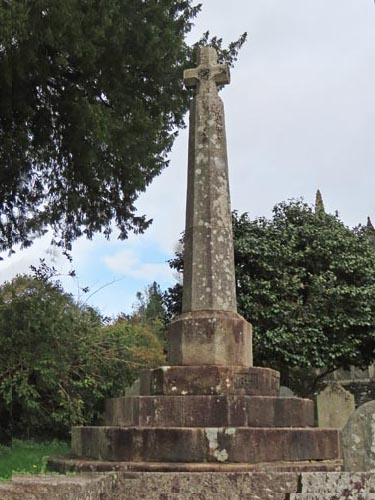
 |
 Location:
Just inside the main gate
of the churchyard and to the left. Location:
Just inside the main gate
of the churchyard and to the left.O/S Grid Ref: SX/48994/68355 Longitude/Latitude (Degrees+/-): -4.13040/50.49548 Map location: Click here to view map. Purpose: The base of the original village preaching cross has been reconstructed to support a memorial cross in the churchyard. Size: This cross is too tall to be accurately measured. I estimate its height to be about 15 feet (4.57 metres) and the width across the arms at about 1 foot 8 inches (0.51 metres). Information: This truly enormous cross is almost entirely modern with only the socket and plinth stones being reused from the original Buckland Monachorum Cross. This preaching cross used to be sited on the village green, which was on the opposite side of the road to the churchyard, but was demolished in the middle of the 19th century to make way for the cottages to be built. I understand that the spot in which it originally stood is now part of the back garden of Bedford Cottage. The socket stone and those used in the plinth were thrown to one side in a discarded heap. The cross now stands in the churchyard on the site of a large horse chestnut tree, which was destroyed in the blizzard of 1891. The main shaft is octagonal in section and tapers upwards. It is composed of three separate sections, which are cemented together and each is of 4 feet in height. The head, which currently sits on top of this shaft, has a short length of its own shaft attached to it and this is much narrower than the main shaft. The head and arms are also octagonal in shape but, unlike the shaft, these are not tapered.
The original head of the cross was of the ‘Lantern’ type with a beautiful gold top to it. It also contained the ornately sculptured figures of St Bernard and St Andrew, together with the Arms of the Sees of Exeter and Buckland Abbey. The head was stored away for safe keeping when the cross was removed – in fact it was so safely stored that it could not be found when the cross was re-erected in the churchyard.
The village of Buckland Monachorum is sometimes locally referred to as Buckland Drake, because of its close links with the Drake family. The church is dedicated to St Andrew and is built in the perpendicular style, with a square tower containing 6 bells. Near the church, is the village public house, the aptly named ‘Drake Manor Inn’. The main part of the building was constructed in the 16th century, by the same masons who built the church. The pub has a welcoming ‘olde worlde’ atmosphere, with old oak beams, open fireplaces and a peaceful pub garden for those long hot summer evenings.
|